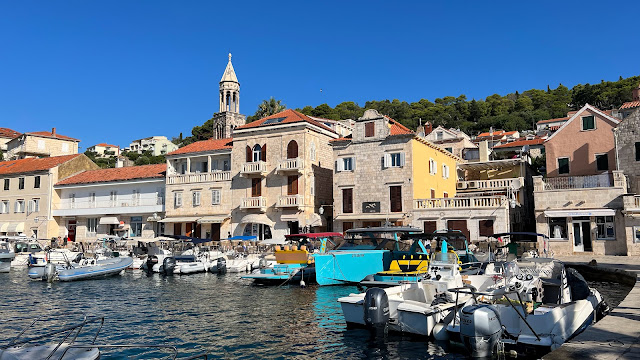 |
| We visited Hvar (blue) but Stari Grad (red) is the ancient capital |
The island of Hvar is located at the centre of the Adriatic sailing routes and that made this island an important base for commanding trade up and down the Adriatic and across to Italy, particularly and importantly Venice. It has been inhabited since prehistoric times, originally by a Neolithic people whose distinctive pottery gave rise to the Hvar culture, and later by the Illyrian people. The ancient Greeks founded the colony of Pharos in 384 BC on the site of today's Stari Grad making it one of the oldest towns in Europe (unfortunately we weren’t to visit that town). The Greeks were also responsible for setting out the agricultural field divisions of the Stari Grad Plain on the northern aspects of the island that is now a UNESCO World Heritage Site. In medieval times, because of its location the town of Hvar located around a natural port on the southern side of the island, and which we visited, rose to importance within the Venetian Empire as a major naval base. It was a prosperous port city. Incidentally the locals call this
Forr (the sound of Hvar in their language) .
 |
| A pretty port |
 |
| Fortifications above the city port |
It is a very picturesque port. Once we landed a wonderful local guide took us to the C15 Franciscan Monastery out on a promontory. The monastery has a wonderful garden with a huge cypress tree whose spreading branches are supported by a network of wire and struts. Part of this stately Renaissance monastery has been turned into the monastery museum - it was wonderful to explore. Along with a collection of old books and coins and other fascinating collections, it houses the famous ‘Last Supper’ painting, a work belonging to the Venetian School of Palma the Younger from the end of the C16, they say.
 |
| The C15 monastry-cum-museum |
 |
| Caper bushes abound and both the berries and flowers are used |
 |
| A very ancient tree. Magnificent |
 |
| The founding Franciscan monk |
 |
| C16 painting of the 'Last Supper' |
 |
| Mechanical clock dating from the C15 - I was intrigued |
 |
| This sundial clock was poorly positioned under the eaves |
After wandering back to the main square past the Cathedral of Saint Stephen, we wended our way through alleys to the Benedictine Monastery, which holds a rich collection of lace made of agave leaves.
 |
| Extreme contrasts - the fastest electric car in the world, on exhibition to be shipped out later that day |
 |
| A delightful bronze fisherman |
 |
| Cathedral of Saint Stephen |
The convent was established in 1664 but the nuns didn’t start producing the agave lace until the C19. Their lacemaking is now a symbol of Hvar and has also been inscribed on UNESCO’s List of the Intangible Cultural Heritage of Humanity. It was exquisitely delicate and very beautiful.
 |
| From this humble plant ..... |
 |
| .... comes this delicate work |
 |
| I managed to capture this nun at work creating lace |
 |
| A sundial on the wall outside the monastery |
 |
| It was affected by 'daylight saving' . They forgot to tell the sun |
 |
| Everywhere there were steps! |
 |
| Typical Venetian house front - doorway and window beside it. Like a storefront |
 |
| Everywhere the Venetian Lion |
 |
| Dated 1475 this urn indicates trouble - lion'x foot on closed book |
 |
| Luscious fruit at a srreet market |
We wandered back to port through a market which whetted our appetite for dinner. Once back on board and after dinner we were treated to a dance spectacular by the on-board artists travelling with us. Sadly my photos couldn’t do the show justice but suffice it to say it was artistic, full of movement and colour and was gorgeous.



























No comments:
Post a Comment